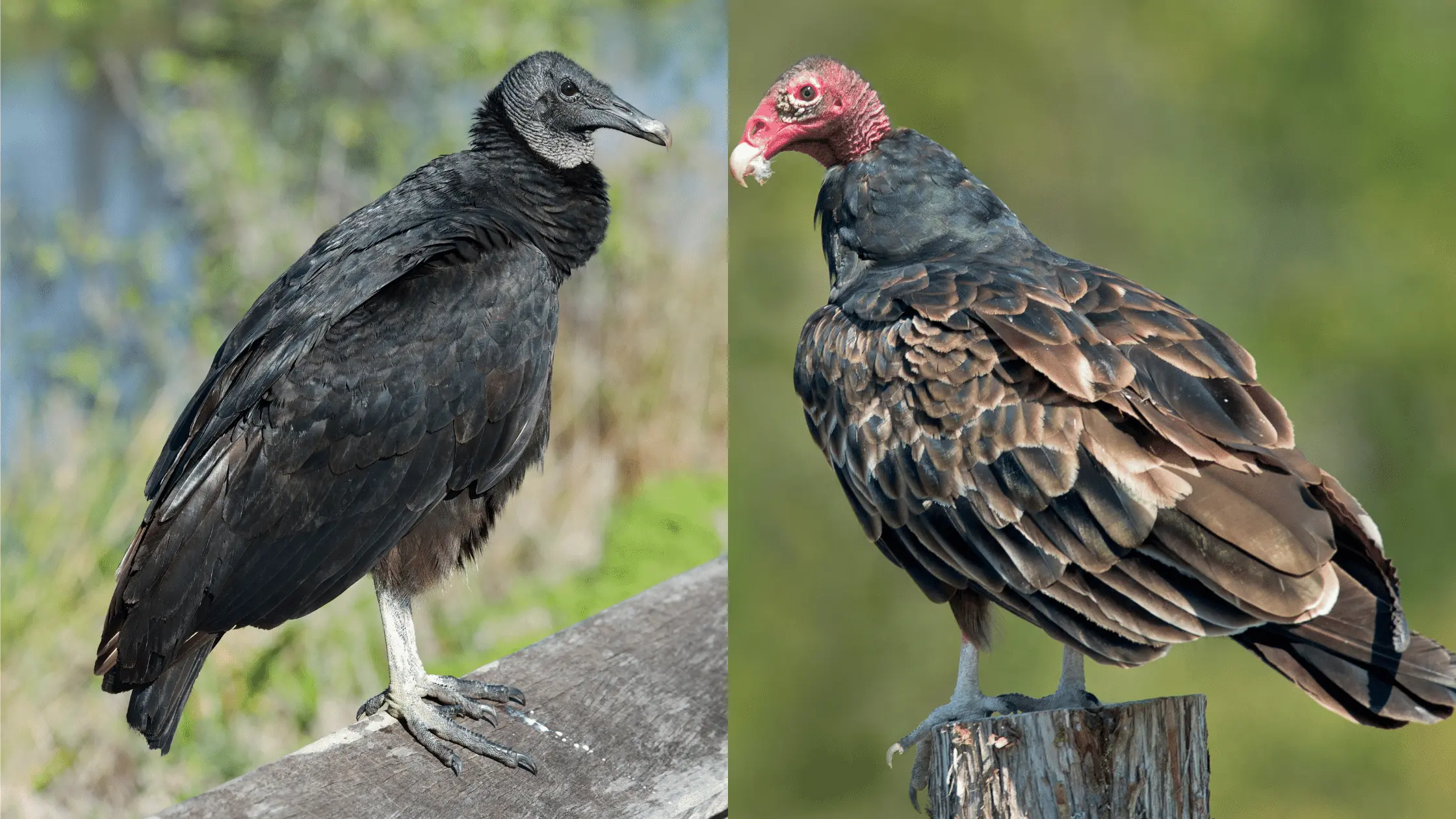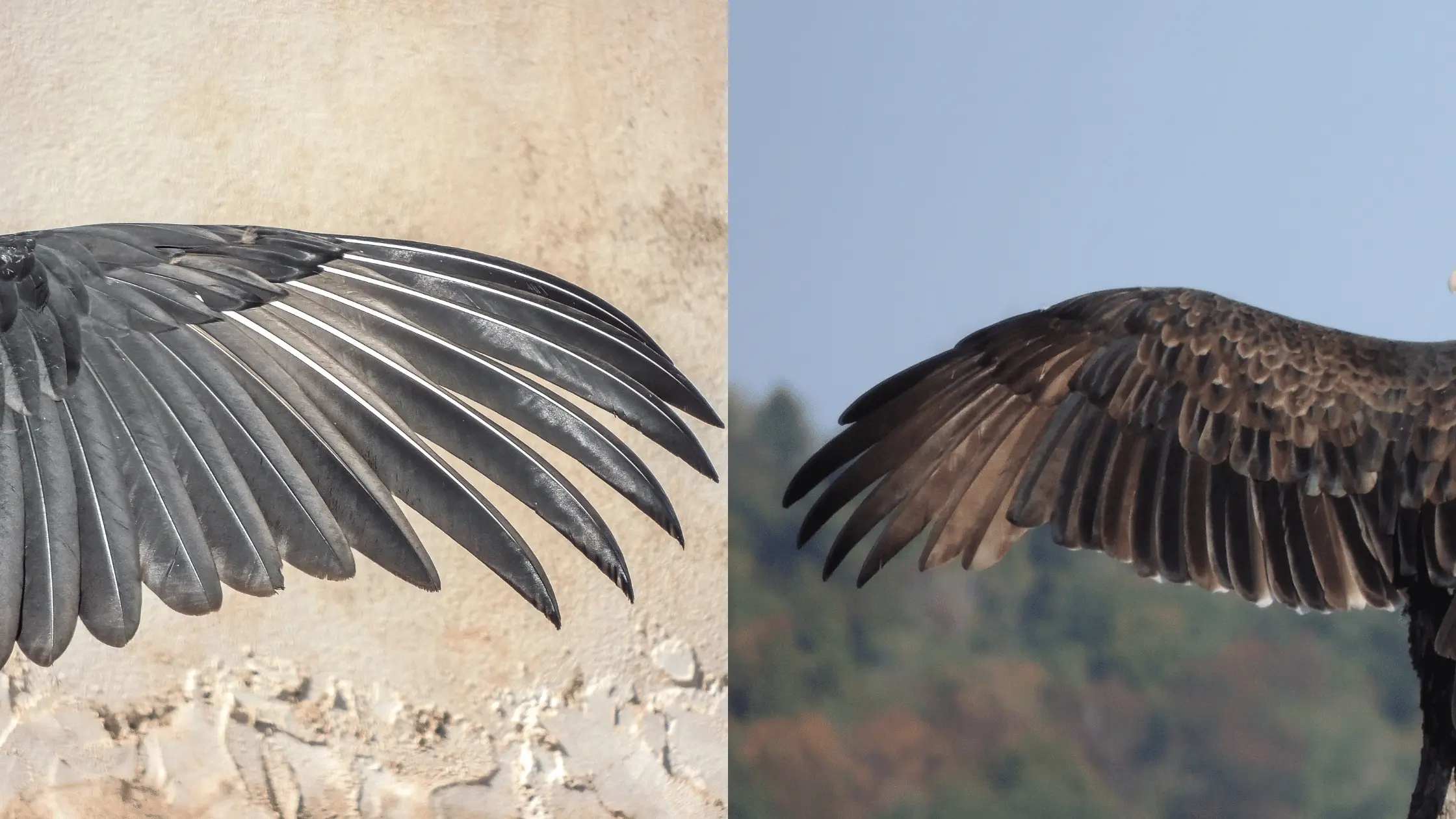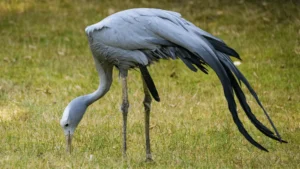Vultures play a crucial role in our ecosystem. They prevent the spread of harmful parasites by feeding on dead animals. Chief among these birds are the black vulture and the turkey vulture.
Both birds are relatively common and are often found together. Also, they share many behavioral traits; many often mistake one for the other.
This article will reveal foolproof evidence that you can use to tell these birds apart.
Physical Appearance

You can easily differentiate between both vultures by looking at their heads.
As it is named, the black vulture’s head and throat are covered with thick layers of dark-gray skin. It also possesses a dark beak with a visibly lighter tip. The nostrils of the black vulture are hard to notice since they are very tiny.
On the other hand, the turkey vulture possesses a redhead with several layers of folded skin. The turkey vultures have a shorter white beak with a strong hook than the black vulture. You can also notice the dominant perforated nostrils on a turkey vulture’s beak.
Another way to tell these birds apart is by observing their build and plumage.
Black vultures have shorter legs and look leaner than their cousins. Their feathers are completely dark, and their short tails are covered by their wings. At the same time, the turkey vulture possesses a dark brown plumage with clearly lighter feather tips. They have long tails which they can hide beneath their wings.
Size
Although both birds are almost the same size, the turkey vulture is slightly larger than the black vulture.
Turkey vultures usually weigh between 70 to 73 pounds. The average black vulture weighs less than 65 pounds, with only a few weighing as much as 75 pounds.
Also, black vultures have shorter wingspans measuring between 54 to 60 inches, which pales in comparison to the 70 inches of wingspan that the turkey vulture averages.
With a length (beak-to-tail length) of up to 32 inches, the turkey vulture also outdoes the black vulture. It is rare to find black vultures longer than 27 inches.
Wing Formations

You can tell black vultures apart from turkey vultures by observing them while in flight.
Black vultures display a pair of completely black wings tipped with silver-gray patches. Their wings are also broad and complemented by a short, round tail.
On the other hand, turkey vultures possess a pair of bicolored wings. The turkey vulture’s silver-gray underwing feathers contrast sharply with the black edges of its branches. Its long tail also forms a triangular shape while in flight.
The turkey vulture spreads its wings in a V-shape while it soars.
Behavioral Traits
You can find black vultures close to human settlements, and they can be seen perching on rooftops, overhead tanks, and utility poles. Meanwhile, turkey vultures are naturally shy and will perch at a reasonable distance from any human settlement.
Black vultures are highly social birds. You will seldom find a black vulture by itself, as they are usually foraging in large flocks.
Turkey vultures are not that social, and they prefer to forage by themselves and rarely move in large groups.
Feeding
Black vultures and turkey vultures are scavenger birds, so they feed mainly on dead animals. However, there is a striking difference in their feeding behavior.
Black vultures have a poor sense of smell and can only detect dead animals while they soar above open and semi-open areas. On the other hand, Turkey vultures have a terrific sense of smell and can readily sniff out any available food sources within a 5-mile radius. Hence, they can forage even in densely forested areas.
Black vultures compensate for their poor sense of smell by soaring above turkey vultures while foraging. This way, they keep track of turkey vultures and follow them to any dead animals they detect.
Black vultures move in sizable flocks. Hence, they will often chase the usually solitary turkey vultures away from any dead animal they find. While dead carcasses constitute the primary diet of both vultures, they are known to prey on small animals.
Turkey vultures will occasionally hunt rats and raid the nests of small birds. Black vultures also prey on lambs, piglets, and young calves.
Reproduction
Black vultures and turkey vultures have different breeding seasons.
While black vultures begin to breed by late January, turkey vultures wait till March. Also, black vultures have a longer breeding season which lasts till August. But the turkey vultures complete their breeding season by June.
However, neither bird builds nests. They both lay their eggs in dark spaces with sufficient cover for their eggs. Both vultures will lay their eggs inside caves, hollow tree trunks, and even in deserted buildings.
Black vultures lay just two eggs, usually requiring between 32 to 45 days of incubation. In contrast, turkey vultures lay between one to three eggs at a time, and pregnancy lasts between 34 to 41 days.
Both vultures feed new hatchlings by regurgitating food. Turkey vultures will leave their young ones to fend for themselves after 11 weeks, while black vultures feed their young for up to eight months.
Frequently Asked Questions
Do Turkey Vultures Migrate?
Turkey vultures are known to migrate to warmer climes in winter. Depending on your location, these vultures could be full residents or part migrants.
Can Black Vultures attack me?
While black vultures stay close to human settlements, they do not threaten you. However, they might strike with their beaks when cornered or handled.
How Do I Keep Black Vultures Away From My Yard?
Black vultures often prey on small rodents found around open trash cans or garbage dumps.
To keep the birds away from your yard, you must keep your yard clean and dispose of litter properly.





